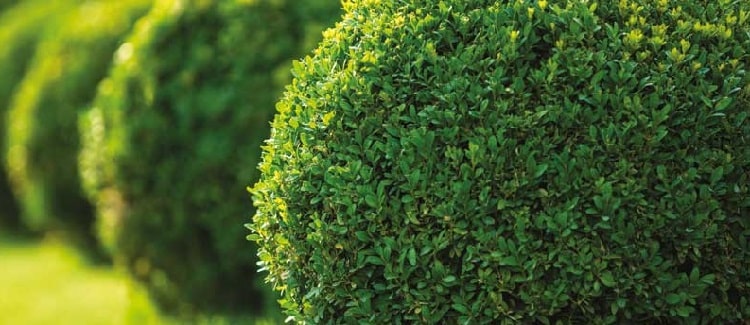Naturally distributed in southwestern Europe and western part of central Europe, North Africa, western Asia, from lowlands to mountainous areas. It is 8 m tall, densely branched, tall shrub or short tree. When old, its branches hang downwards. The bark of the trunk is gray brown, rough. Shoots are quadrangular, green, densely hairy. Later shoots are rounded. Evergreen leaves are egg-shaped or elliptical, 1-2 cm long, dark green and leathery on the upper side, lighter on the lower side, pubescent along the midrib. Flowers are pale green with yellow filaments. It blooms in April and May.
There are many different species and garden forms in its natural growing environment. One of them is Buxus sempervirens ‘Bullata’. Buxus sempervirens ‘Bullata’ is 2-3 m tall and wide. It is an upright and fast growing shrub. The leaves are dark blue green broad egg-shaped rounded 2.5 cm long. It is very vigorous. Not affected by air pollution. Very resistant to frosts. Semi-shade and shady areas are very suitable for sparse and free-growing shrubs. Boxwood can be pruned after winter frosts. Very suitable as a hedge plant. Resistant to air pollution and cold. Buxus Sempervirens >>
Buxus sempervirens care
Caring for Buxus sempervirens, commonly known as Common Boxwood or European Boxwood, involves a few key practices to ensure the health and beauty of the shrub. Here are the essential care guidelines:

- Sunlight: Common Boxwood prefers partial to full sun, with at least 4-6 hours of direct sunlight each day. In hot climates, some afternoon shade can be beneficial to prevent stress on the plant.
- Soil: Ensure the soil is well-drained, as Common Boxwood is sensitive to waterlogged roots. Amending the soil with organic matter, such as compost, can help improve drainage and fertility.
- Watering: Water your Common Boxwood regularly, especially during dry spells. The soil should be kept consistently moist but not waterlogged. Water deeply, allowing the top inch of soil to dry out between watering.
- Mulching: Apply a layer of mulch around the base of the shrub to retain soil moisture, suppress weeds, and regulate soil temperature. Be sure to keep the mulch away from the stem to prevent rot.
- Fertilization: Common Boxwood does not typically require heavy fertilization. However, you can apply a balanced, slow-release fertilizer in the spring to promote healthy growth. Follow the manufacturer’s instructions for application.
- Pruning: Pruning is essential to maintain the desired shape and size of your Common Boxwood. Prune in late spring or early summer after the initial flush of growth. Regular pruning helps keep the shrub neat and dense.
- Pest and Disease Management: Common Boxwood can be susceptible to certain pests and diseases, such as boxwood leafminer and boxwood blight. Regularly inspect your shrub for signs of infestations or diseases and take appropriate measures to address them, including the use of insecticides or fungicides if necessary.
- Protection from Harsh Winter Weather: In colder regions, provide some protection from extreme cold and winter winds, especially for young or newly planted boxwood. Use burlap or other coverings to shield the shrub during the winter months.
- Deer Protection: If your area has a deer population, consider protecting your Common Boxwood from deer browsing with appropriate fencing or deer repellents.
- Regular Monitoring: Regularly inspect your Common Boxwood for any signs of stress, pests, or disease. Promptly address any issues to maintain the plant’s health.
Proper care and maintenance are essential to keep Common Boxwood looking its best and thriving in your garden or landscape. These shrubs are known for their adaptability and versatility, making them valuable additions to various outdoor settings.
